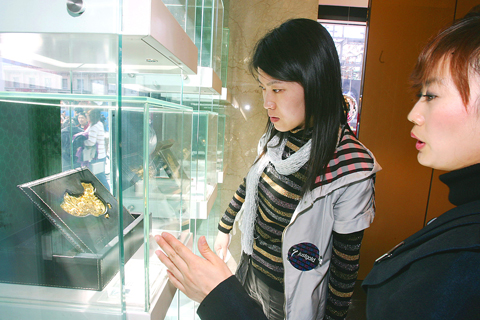Li Zhixin spent weeks planning his one-day family tour of Beijing’s historic sites, but instead found himself in one of the city’s shopping malls, watching his wife happily trying on gold necklaces.
“I can’t complain — we just like gold,” said the 30-year-old steel plant worker from Tangshan, an industrial city southeast of Beijing.
“Gold is a better store of wealth than platinum,” he said, as his mother-in-law counted a wad of cash beside him. “Of course, diamonds are lovely. But we can’t afford the big ones and are not interested in small stones.”

PHOTO: AFP
They finally bought a pendant necklace for more than 3,000 yuan (US$439), more than two months’ income for an average Chinese urban resident.
With per-capita disposable income in cities up 17.2 percent to 13,786 yuan last year, gold jewelry is no longer beyond the reach of masses of Chinese consumers on the lookout for something luxurious.
“People buy gold jewelry for anniversaries, weddings, or as gifts for holidays,” said Daisy Yan, a saleswoman at the Xin Dong An Department Store in downtown Beijing.
“First it’s a pretty adornment, also I think it’s maybe about vanity, a way to show how rich the wearer is,” she said.
Figures from the World Gold Council showed sales of gold jewelry in China hit a record high of 302.2 tonnes last year, up 34 percent on the previous year.
China has now overtaken the US to become the world’s second-largest buyer of gold jewelry after India.
But behind the growth lies a deep Chinese traditional appreciation of the precious metal as a hedge against social and economic risks.
“I’m more confident in gold — we’ve been buying it for so many years in the past anyway,” said 78-year-old Wu Peifen, who was selecting a wedding gift for her grandson at Beijing’s Wangfujing Department Store (王府井百貨).
High inflation and a 41 percent slump in the stock market this year have added further momentum to China’s drive to buy gold.
“The stock market is not as good as before and people do not feel safe parking all their savings in banks,” said Lin Yuhui (林煜輝), an analyst with the China International Futures (中國國際期貨經紀有限公司) in Shenzhen.
“So they tend to buy gold as a means to hedge inflationary risks,” Lin said.
Spurred by strong demand and international price rises, 1g of pure gold jewelry sold at a new high of 242 yuan in Beijing last month, up 9 percent in just two months, earlier state media reports said.
On the London Bullion Market, the price of gold rose to US$944.13 per ounce on Friday, up more than 37 percent from a year ago.
But Chinese consumers are not deterred by rising prices, experts said. Rather, they increasingly view gold as not only a means to protect wealth but also as an efficient part of their investment portfolio.
“In fact, higher gold prices helped to stimulate investment purchases of the metal ... as consumers were attracted by the strong returns generated by the metal,” the World Gold Council said in a recent report about the China market.
It said investment demand for gold at the retail level amounted to 23.9 tonnes last year, a rise of 60 percent compared with 2006.
However, for young Chinese, fashion appears to be more important than potential return.
“What I want is something fashionable and special,” said Zhang Xiangyu, a 25-year-old beauty parlor worker, as she browsed gold earrings and bracelets in a jewelry store with her boyfriend.
“I won’t waste time thinking too much — I’ll buy it as long as I like the look of it,” she said.

CHIP RACE: Three years of overbroad export controls drove foreign competitors to pursue their own AI chips, and ‘cost US taxpayers billions of dollars,’ Nvidia said China has figured out the US strategy for allowing it to buy Nvidia Corp’s H200s and is rejecting the artificial intelligence (AI) chip in favor of domestically developed semiconductors, White House AI adviser David Sacks said, citing news reports. US President Donald Trump on Monday said that he would allow shipments of Nvidia’s H200 chips to China, part of an administration effort backed by Sacks to challenge Chinese tech champions such as Huawei Technologies Co (華為) by bringing US competition to their home market. On Friday, Sacks signaled that he was uncertain about whether that approach would work. “They’re rejecting our chips,” Sacks

NATIONAL SECURITY: Intel’s testing of ACM tools despite US government control ‘highlights egregious gaps in US technology protection policies,’ a former official said Chipmaker Intel Corp has tested chipmaking tools this year from a toolmaker with deep roots in China and two overseas units that were targeted by US sanctions, according to two sources with direct knowledge of the matter. Intel, which fended off calls for its CEO’s resignation from US President Donald Trump in August over his alleged ties to China, got the tools from ACM Research Inc, a Fremont, California-based producer of chipmaking equipment. Two of ACM’s units, based in Shanghai and South Korea, were among a number of firms barred last year from receiving US technology over claims they have

BARRIERS: Gudeng’s chairman said it was unlikely that the US could replicate Taiwan’s science parks in Arizona, given its strict immigration policies and cultural differences Gudeng Precision Industrial Co (家登), which supplies wafer pods to the world’s major semiconductor firms, yesterday said it is in no rush to set up production in the US due to high costs. The company supplies its customers through a warehouse in Arizona jointly operated by TSS Holdings Ltd (德鑫控股), a joint holding of Gudeng and 17 Taiwanese firms in the semiconductor supply chain, including specialty plastic compounds producer Nytex Composites Co (耐特) and automated material handling system supplier Symtek Automation Asia Co (迅得). While the company has long been exploring the feasibility of setting up production in the US to address

OPTION: Uber said it could provide higher pay for batch trips, if incentives for batching is not removed entirely, as the latter would force it to pass on the costs to consumers Uber Technologies Inc yesterday warned that proposed restrictions on batching orders and minimum wages could prompt a NT$20 delivery fee increase in Taiwan, as lower efficiency would drive up costs. Uber CEO Dara Khosrowshahi made the remarks yesterday during his visit to Taiwan. He is on a multileg trip to the region, which includes stops in South Korea and Japan. His visit coincided the release last month of the Ministry of Labor’s draft bill on the delivery sector, which aims to safeguard delivery workers’ rights and improve their welfare. The ministry set the minimum pay for local food delivery drivers at